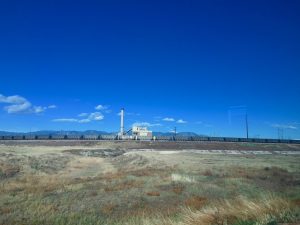COLORADO SPRINGS — America runs on electricity.
It powers our phones, turns the gears in our machines, and keeps our homes cool in sweltering heat.
The United States consumes around 18 percent of the world’s energy supply, according to the U.S. Energy Information Administration (EIA). Only 17 percent of our electricity comes from renewable sources.
“The sun doesn’t always shine and the wind doesn’t always blow,” said David Padgett. He’s the head of environmental services at Colorado Springs Utilities.
Padgett helps oversee the city’s municipal coal, natural gas, and solar plants at Clear Spring Ranch. It’s located on the plains of Colorado’s front range, about 20 miles from downtown Colorado Springs.

On the fenced property, a smokestack shaped like a rocket ship interrupts the blue sky. From the north, a train snakes across the land. Its cars are loaded with ink-black coal.
Energy is contentious. Fossil fuels like coal, oil and natural gas come from thousand-year old deposits in the earth. The plant matter has been crushed into dense, combustible substances. They are extracted. And then burned.
The burning process has side effects. It releases greenhouse gases like carbon dioxide, methane, and nitrous oxide into the atmosphere. In normal levels, these gases help regulate the planet’s temperature. But since the industrial revolution, the concentration of greenhouse gases has magnified.
The earth is warming at an unprecedented rate.
A new report by the United Nations offers dismal figures for our future. If we keep burning fossil fuels at the rate we’re going, the planet will warm by at least 2.7 degrees Fahrenheit by 2040.
If we want to stop the predicted warming – and the fires, droughts, floods, and severe storms that will come with it – we need to reduce our 100% of our emissions by 2050.

To meet that goal, the U.N. recommends a halt in fossil fuel powered electricity. In the next 32 years, coal should be frozen into obsolescence. Renewable energy should take the stage.
Clear Springs Ranch offers a unique glimpse into the tug-of-war between fossil fuels and renewable energy. Coal and natural gas are cheap. It costs Colorado Springs Utilities approximately $16-17 per megawatt hour (Mwh) to produce coal-powered energy, $18-19 for natural gas, and almost double – $31 per Mwh – for solar.
Padgett points to consumers. “What is everyone in this room willing to pay for electricity?” he asked.
At the moment, Colorado Springs Utilities’ generates 11% of their power from renewable energy. By 2020, they want to double that.
Yet fossil fuels still burn on Clear Springs Ranch. The black-and-blue, glinting solar panels in a field off of I-25 look small next to the towering, technical, smoke-producing coal and gas operations just a mile away.
In a city like Colorado Springs, would it be possible to transition fully to renewables? Padgett isn’t confident.
“I’m not sure the world can ever get there,” he said.

